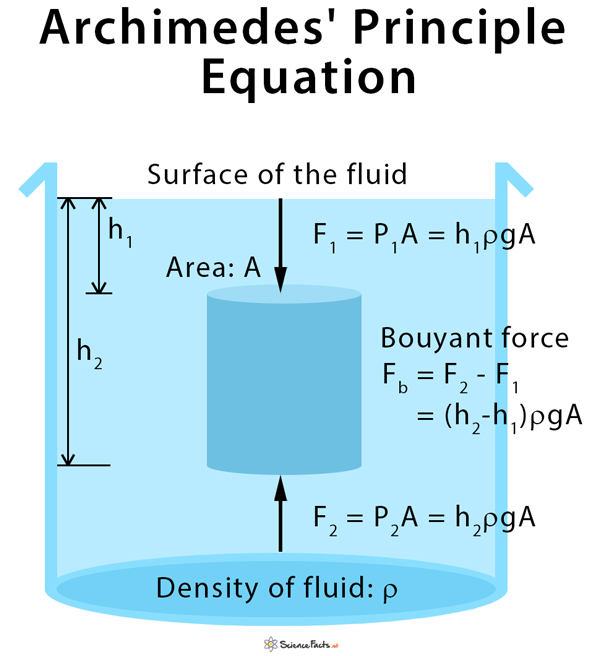

When the water occupied that space, it was supported by the water below it. That is, they're taking the water's place. Its level rises because the disks are "displacing" some of the water. Now gradually lower the disks into the water. When that's done, raise the scale back up. A lot of water will overflow into the cylinder. What's the source of this force? With the cork and aluminum disk pair attached to the scale, lower the scale as far as it will go. What is the "Fluid Displaced" and How is its Weight Related to the Buoyant Force? In the preceding section, you focused on the buoyant force as an apparent reduction in the weight of the submerged object. If you lower the disk further, the buoyant force becomes larger and the submerged weight, W ′, is reduced by an equal amount. It's an upward force caused by the pressure on the bottom of the disk. The buoyant force is the part of the weight that the scale no longer has to support because a new upward force is present. This value, 0.68 N, is the buoyant force. That's the "submerged weight." We'll use the termį b = W − W ′ = 4.41 N − 3.73 N = N. Let's use that value in the following discussion. This is a judgment call since the location of the half-way point is uncertain. Slowly drag the support arm above the scale downward until the aluminum disk is about half submerged. Now for the "(submerged) weight when fully or partially immersed in the water." Drag the object back to the hanging scale. This will only happen when we need to weigh the graduated cylinder. Which scale should you use? We'll always use the value from the hanging scale, 4.41 N in this case, unless we have to use the digital scale for a measurement. Drag and drop it on the digital scale and you'll get a more precise answer of about 4.41 N.

Zooming in and estimating a digit we might have 4.41 N. (If it refuses to attach, you probably have the scale already lowered somewhat, or there might be some water in the graduated cylinder.) You should find that it weighs about 4.4 N. (Zoom back out.) Now drag the cork and aluminum compound object and drop it somewhere below the hanger. Our simulation reflects that level of precision. Right (or Ctrl) click and zoom in on the hanging scale. What's a "Buoyant Force", and What Exerts it? Let's try it with the system in Figure 1. Both refer to an object fully or partially in a fluid. While we're at it, our use of submerged in some cases and immersed in others is not meant to suggest two different phenomena. So, our exploration of the apparatus will mainly focus on the various situations you'll encounter and the related terminology. This and many other phrases you'll hear when studying buoyancy are mostly meaningless without direct experience. There aren't too many choices.Ī body wholly or partially immersed in a fluid will experience a buoyant force equal to the weight of the fluid displaced. When you try to move an onscreen object and it doesn't behave as expected, this means that something else needs to be done first. Another thing that is largely forbidden is dragging the screen when you're zoomed in. Similarly, you can't weigh more than one object on the digital scale at a time, and you can't make a mess by lowering an object into the water while the cylinder is on the digital scale. For example, if you remove the cork and aluminum object from the hanging scale and then attach a new object to the scale, you'll find no further overflow is possible without first emptying the cylinder. You'll find that some actions that could be done with real apparatus are forbidden. The graduated cylinder is emptied by dragging and releasing it above the tank. Both the hanging scale and the graduated cylinder can be read more precisely by zooming in.

The hanging scale is raised and lowered by dragging the metal arm that supports it. These objects can be weighed in air and when partially or fully submerged. They are composed of cork, aluminum, and an unknown material. Two simple and two compound objects are available for study. The volume of this displaced water can be read from the graduated cylinder, and the weight of the water can be found by weighing the graduated cylinder before and after overflow. The overflow of water from the tank spills into a graduated cylinder. A hanging scale and a digital scale are available for measuring the weights of our objects. We also need to measure the weight and volume of the fluid displaced. We'll use water as our fluid in this lab. To investigate buoyant forces, we need to measure the weight and volume of objects as well as their submerged weight when fully or partially immersed in a fluid.


 0 kommentar(er)
0 kommentar(er)
